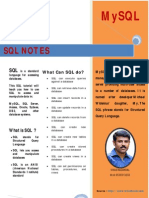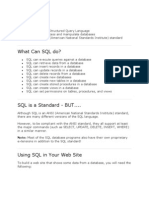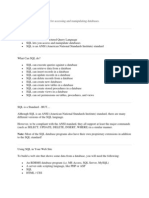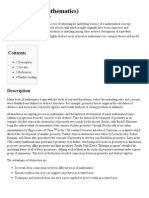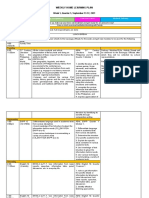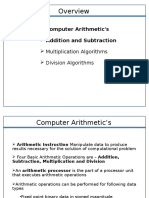What Is SQL?: SQL Is A Standard Language For Accessing and Manipulating Databases
Uploaded by
Thirupathireddy MadireddyWhat Is SQL?: SQL Is A Standard Language For Accessing and Manipulating Databases
Uploaded by
Thirupathireddy MadireddySQL is a standard language for accessing and manipulating databases.
What is SQL?
SQL stands for Structured Query Language SQL lets you access and manipulate databases SQL is an ANSI (American National Standards Institute) standard
What Can SQL do?
SQL can execute queries against a database SQL can retrieve data from a database SQL can insert records in a database SQL can update records in a database SQL can delete records from a database SQL can create new databases SQL can create new tables in a database SQL can create stored procedures in a database SQL can create views in a database SQL can set permissions on tables, procedures, and views
Using SQL in Your Web Site
To build a web site that shows data from a database, you will need: An RDBMS database program (i.e. MS Access, SQL Server, MySQL) To use a server-side scripting language, like PHP or ASP To use SQL to get the data you want To use HTML / CSS
RDBMS
RDBMS stands for Relational Database Management System. RDBMS is the basis for SQL, and for all modern database systems such as MS SQL Server, IBM DB2, Oracle, MySQL, and Microsoft Access. The data in RDBMS is stored in database objects called tables. A table is a collection of related data entries and it consists of columns and rows. Database Tables A database most often contains one or more tables. Each table is identified by a name (e.g. "Customers" or "Orders"). Tables contain records (rows) with data. In this tutorial we will use the well-known Northwind sample database (included in MS Access and MS SQL Server). Below is a selection from the "Customers" table:
Demo Database CustomerID CustomerName ContactName Address
1 2 Alfreds Futterkiste Ana Trujillo Emparedados y helados
City
PostalCode Country
12209 Germany Mexico
Maria Anders Obere Str. 57 Berlin Ana Trujillo Avda. de la Constitucin 2222 Mataderos 2312
Mxico 05021 D.F. Mxico 05023 D.F.
3 4 5
Antonio Moreno Antonio Taquera Moreno
Mexico UK Sweden
Around the Horn Thomas Hardy 120 Hanover London WA1 1DP Sq. Berglunds snabbkp Christina Berglund Berguvsvgen Lule 8 S-958 22
SQL Statements
Most of the actions you need to perform on a database are done with SQL statements. The following SQL statement selects all the records in the "Customers" table:
Example
SELECT * FROM Customers; In this tutorial we will teach you all about the different SQL statements. SQL is NOT case sensitive: SELECT is the same as select
Semicolon after SQL Statements?
Some database systems require a semicolon at the end of each SQL statement. Semicolon is the standard way to separate each SQL statement in database systems that allow more than one SQL statement to be executed in the same call to the server. In this tutorial, we will use semicolon at the end of each SQL statement. Some of The Most Important SQL Commands
SELECT - extracts data from a database UPDATE - updates data in a database DELETE - deletes data from a database INSERT INTO - inserts new data into a database CREATE DATABASE - creates a new database ALTER DATABASE - modifies a database CREATE TABLE - creates a new table ALTER TABLE - modifies a table DROP TABLE - deletes a table CREATE INDEX - creates an index (search key) DROP INDEX - deletes an index
The SQL SELECT Statement
The SELECT statement is used to select data from a database. The result is stored in a result table, called the result-set. SQL SELECT Syntax SELECT column_name,column_name FROM table_name; and SELECT * FROM table_name; The following SQL statement selects the "CustomerName" and "City" columns from the "Customers" table:
Example
SELECT CustomerName,City FROM Customers; The following SQL stament selects all the columns from the "Customers" table:
Example
SELECT * FROM Customers;
The SELECT DISTINCT statement
The SELECT DISTINCT statement is used to return only distinct (different) values. The SQL SELECT DISTINCT Statement In a table, a column may contain many duplicate values; and sometimes you only want to list the different (distinct) values. The DISTINCT keyword can be used to return only distinct (different) values.
SQL SELECT DISTINCT Syntax
SELECT DISTINCT column_name,column_name FROM table_name; The following SQL statement selects only the distinct values from the "City" columns from the "Customers" table:
Example
SELECT DISTINCT City FROM Customers;
The SQL WHERE Clause
The WHERE clause is used to filter records. The WHERE clause is used to extract only those records that fulfill a specified criterion.
SQL WHERE Syntax
SELECT column_name,column_name FROM table_name WHERE column_name operator value; The following SQL statement selects all the customers from the country "Mexico", in the "Customers" table:
Example
SELECT * FROM Customers WHERE Country='Mexico';
Text Fields vs. Numeric Fields
SQL requires single quotes around text values (most database systems will also allow double quotes). However, numeric fields should not be enclosed in quotes:
Example
SELECT * FROM Customers WHERE CustomerID=1;
Operators in The WHERE Clause
The following operators can be used in the WHERE clause:
Operator
= <> > < >= <= BETWEEN LIKE IN
Description
Equal Not equal. Note: In some versions of SQL this operator may be written as != Greater than Less than Greater than or equal Less than or equal Between an inclusive range Search for a pattern To specify multiple possible values for a column
You might also like
- Basics of iOS Application Development - Beginning DevOps On AWS For iOS Development - Xcode, Jenkins, and Fastlane Integration On The CloudNo ratings yetBasics of iOS Application Development - Beginning DevOps On AWS For iOS Development - Xcode, Jenkins, and Fastlane Integration On The Cloud10 pages
- SQL Is A Standard Language For Accessing and Manipulating DatabasesNo ratings yetSQL Is A Standard Language For Accessing and Manipulating Databases19 pages
- What Is SQL?: SQL Is A Standard Language For Accessing and Manipulating DatabasesNo ratings yetWhat Is SQL?: SQL Is A Standard Language For Accessing and Manipulating Databases15 pages
- Implementing Samba 4 1st Edition Edition Marcelo Leal - Read the ebook online or download it to own the full content100% (1)Implementing Samba 4 1st Edition Edition Marcelo Leal - Read the ebook online or download it to own the full content57 pages
- 1524 - შებლ ებადი, ალ-არაბი ემარა - მონუმენტური წარწერა თბილისის გალავანზე - არქეოლოგიური და ისტორიული კვლევაNo ratings yet1524 - შებლ ებადი, ალ-არაბი ემარა - მონუმენტური წარწერა თბილისის გალავანზე - არქეოლოგიური და ისტორიული კვლევა7 pages
- Quarter 1 WEEK 1.2: 21 Century Literature From The Philippines and The World100% (3)Quarter 1 WEEK 1.2: 21 Century Literature From The Philippines and The World6 pages
- Reasoning Strategy with CHECKLIST by THE PUNDITS_editedNo ratings yetReasoning Strategy with CHECKLIST by THE PUNDITS_edited1 page
- Grammar Frequently Tested at Pet Writing Part 1No ratings yetGrammar Frequently Tested at Pet Writing Part 14 pages
- Weekly Home Learning Plan: Week 1, Quarter 1, September 13-17, 2021No ratings yetWeekly Home Learning Plan: Week 1, Quarter 1, September 13-17, 20213 pages



